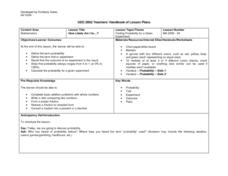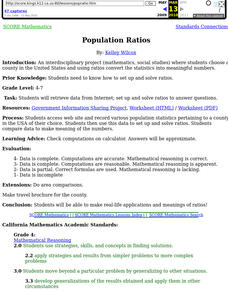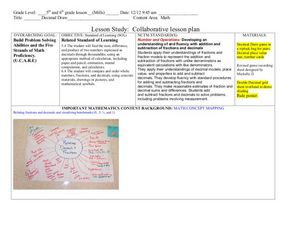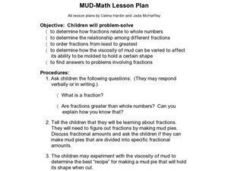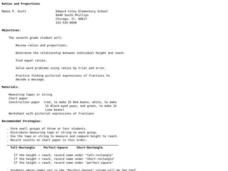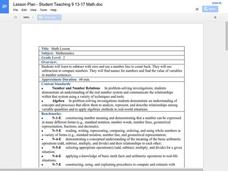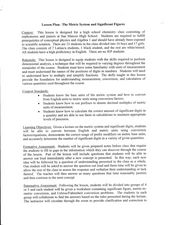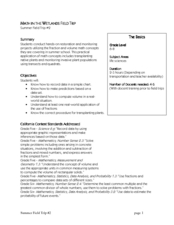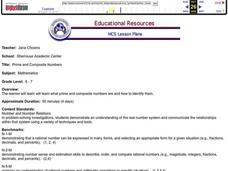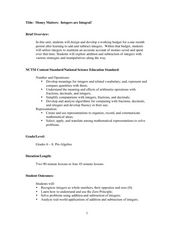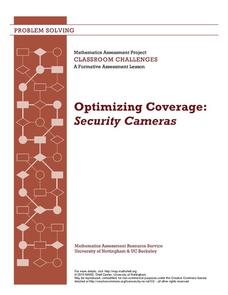Curated OER
Ratios
Sixth graders use ratios to solve unit problems. Pupils write ratios in three different ways. In groups, they perform a bean activity, find ratios, and write them in simplest form.
Curated OER
Counting on Counting
Students recognize that counting tells how many objects are in the set irrespective of how they are arranged or the order in which they are counted. They solve problems involving one more or less to a given set using their knowledge of...
Curated OER
Sorting Nets
Students explore sorting networks. In this computer science lesson, students problem solve as they investigate a parallel processing sorting network.
Curated OER
Ratio Relationships
Students solve for the different ratio and proportion of a problem. In this geometry lesson, students show their knowledge of how to solve proportional relationships. They convert between percent, decimals and fractions.
Curated OER
Probability: How Likely Am I to...?
Twelfth graders examine various ways probability is applied to daily situations. They use marbles and blocks to calculate the probabilities of picking certain colors. They also calculate the odds of picking a winning raffle ticket.
Curated OER
Population Ratios
Students access web site and record various population statistics pertaining to a county in the USA of their choice. They use this data to set up and solve ratios. They compare data to make meaning of the numbers.
Curated OER
Decimals: Collaborative Lesson
Students explore mathematics by participating in a group activity. In this number value lesson, students identify the uses for decimals and how to best estimate whole numbers based on decimals and fractions. Students collaborate with...
Curated OER
The Box with the Greatest Volume
Students use measurement tools to measure the nearest 16th of an inch. They connect fractions and their decimal equivalents and compare this with other decimals. Finally, the class uses algebraic concepts and formulas to solve problems.
Curated OER
Lesson Plan for Fontana Mines
Students estimate and compute with rational numbers. They compare, order and convert among fractions, decimals and percents. Students analyze problems to determine if there is sufficient or extraneous data to solve.
Curated OER
Mixing Colours
Students explore ratios and their relationships to fractions. They explain the process of identifying ratios and describe their comparison. Students write ratios as fractions and by using colons. They convert the ratios to percents.
Curated OER
Mud Pies
Young scholars determine how fractions relate to whole numbers. They determine the relationship among different fractions and order fractions from least to greatest. They
determine how the viscosity of mud can be varied to affect its...
Curated OER
Adding Decimals with Hundredths
For this worksheet, students learn to add decimal numbers to the hundredths. Students first compare adding and subtracting decimals with the corresponding fractions in 6 problems. Then students add 35 decimal numbers mentally, filling...
Curated OER
Ratios and Proportions
Seventh graders explore the concept of ratios and proportions. In this ratios and proportions activity, 7th graders work in groups to measure their heights and their arm span. Students compare their height to their arm span. Students...
Curated OER
Number Line Math
Second graders use a number line to practice subtraction. In this subtraction lesson, 2nd graders use a number line to count backwards. Students participate in mad math activities and solve problems.
Curated OER
ExplorA-Pond:3rd Grade Probability
Third graders cut a map of a pond into grid squares. They count the total number of squares and calculate the probability of drawing a pond piece vs. a shoreline piece. They draw 10 pieces and compare the results with the original...
Curated OER
Area graphics for 7th graders
Pupils randomly select dimensions for three geometric shapes (square, right triangle and circle). From the graphs they compare and contrast the graphical results of each shape.
Curated OER
Cost Comparison
Students take a tour of a produce department in a grocery store. They explore the concepts of money and a budget. They complete problem solving activities and taste different fruits and vegetables.
Curated OER
The Metric System and Significant Figures
Students compare and contrast the English and Metric system. In this chemistry instructional activity, students demonstrate how to convert English to metric and vise versa. They solve problems following the rules of significant figures.
Curated OER
Penny Basketball: Making Sense of Data
Explore four web-based interactive sites to develop a baseline understanding of statistics. Learners play a series of penny basketball games and collect data regarding their shooting statistics. Groups decide who is the "top" penny...
Curated OER
Math in the Wetlands Field Trip
Get your class out in the environment for hands on math activities. In this wetlands lesson, learners transplant native plants, calculate how much soil is needed, and perform math activities based on this experience. They then make...
02 x 02 Worksheets
Inverse Variation
Discover an inverse variation pattern. A simple lesson plan design allows learners to explore a nonlinear pattern. Scholars analyze a distance, speed, and time relationship through tables and graphs. Eventually, they write an equation to...
Curated OER
Prime and Composite Numbers
Prime and composite numbers are the focus of this mathematics lesson. In it, learners practice techniques for identifying these two types of numbers. They utilize the Inspiration program to complete a task that is clearly explained, and...
National Security Agency
Money Maters: Integers are Integral!
A thoroughly-written lesson plan and a plethora of worksheets about integers comprise this resource. Neophyte number crunchers learn to recognize integers, add and subtract them, and apply the concepts to the designing of a personal...
Mathematics Assessment Project
Optimizing Coverage: Security Cameras
Are you being watched? Class members determine where to place security cameras protecting a shop. They then evaluate their own and several provided solutions.




